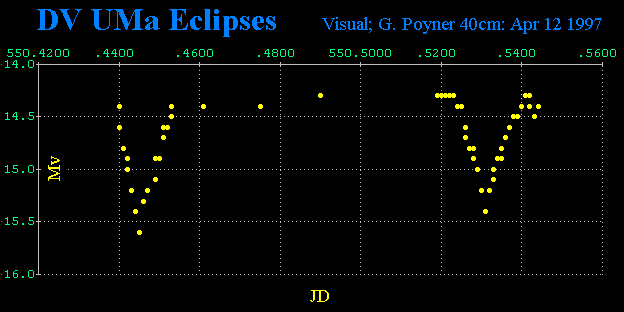
This eclipsing UGSU star (which is on the recurrent objects programme) has been detected in outburst independently by Timo Kinnunen and Tonny Vanmunster on April 8th at magnitude 13.9. The previous outburst - and the first to be visually detected - occurred on Feb. 26th 1995. DV UMa was discovered by Usher et al in 1981, and identified to be eclipsing by Howell et al in 1988, whose photometric observations showed deep eclipses of 1.5 mag or more with an orbital period of 0.08597 day. The eclipses lasted slightly less than 20 min. Unfiltered time series photometry by Vanmunster on April 9/10th 1997 over a 4.8hr period revealed prominent superhumps (0.35 mag) and three eclipses. These are the first superhumps to be detected in this system, thus confirming its UGSU status. The outburst lasted 16 days, as compared to the 1995 one (which was not a supermax) of 4 days.
An attempt to observe eclipses visually in DV UMa by the Director on April 12/13 resulted in the light curves shown below. The time of minima in each of the two eclipses agrees well with the orbital period of DV UMa (2h 04m). One estimate was made every minute resulting in the first eclipse showing a 1.4 magnitude drop in brightness, and the second 1.1 magnitude. DV UMa was slightly brighter at the start of the second eclipse. A noticeable drop in magnitude of 0.25 mag immediately followed the second eclipse, which could have been related to a superhump. It is very regrettable that the visual monitoring did not continue following this second eclipse. Needless to say, a prolonged observing run over several hours will be carried out at the next superoutburst in the hope of detecting superhumps visually - weather permitting!

DSS field of DV UMa
| For some strange reason, DV UMa receives poor coverage from UK observers, despite itís obvious attractions of eclipses and large amplitude superhumps. Itís magnitude at maximum brightness is around 14.0 (at supermaximum) and ordinary outbursts around 14.5 - both well within the limits of a 10 inch! Observers are asked to add this star to their observing programme, in the hope of detecting more outbursts (and eclipses) in this exciting dwarf nova. |